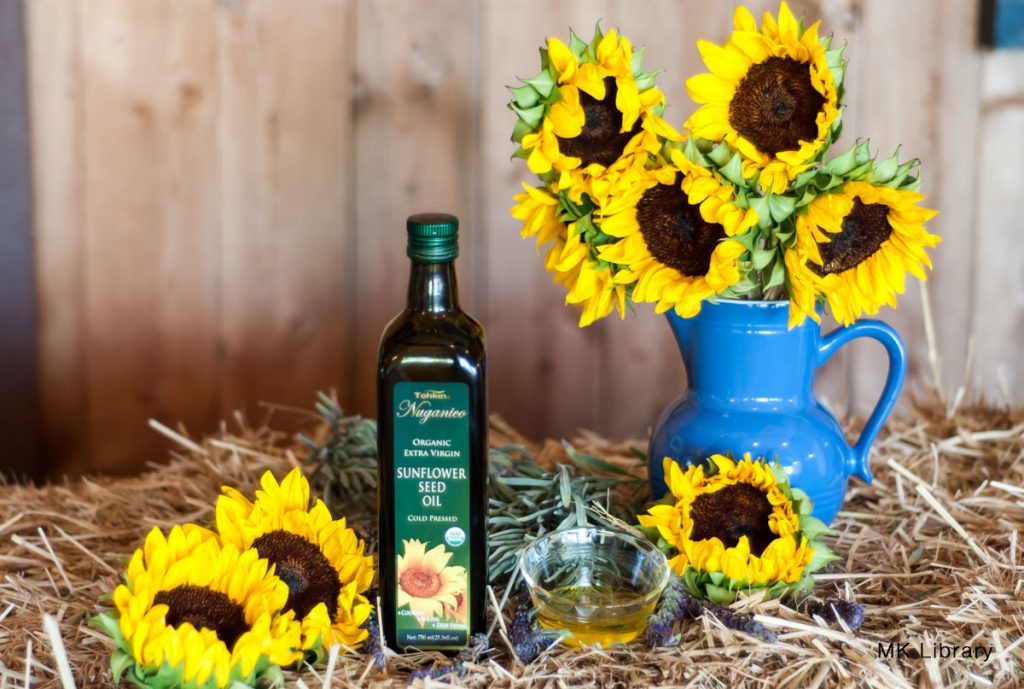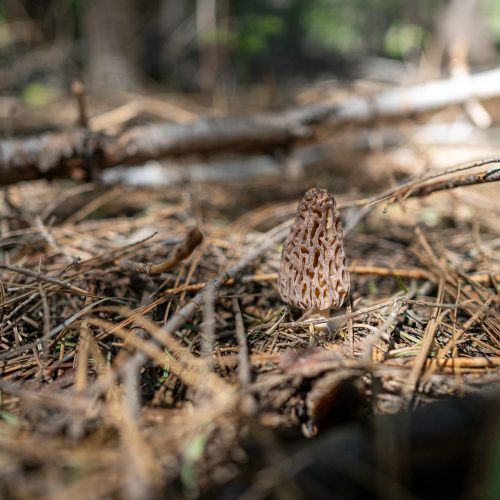Sunflower Seed Oil is a light, healthy oil to incorporate into your cooking. From its immense vitamin E and omega-6 content to anti-inflammatory properties and phytosterol compounds, a high smoke point of 440°F / 225°C provides an incredibly versatile oil. Grab your spatula – let’s learn how to properly use sunflower seed oil in your kitchen, as well as some of its proven health benefits. Sunflowers are one of the five largest oilseed crops in the world, accounting for between 8-11 percent of world vegetable trade [1]. Sunflower seed oil is widely used throughout the United States, Russia, Europe, and the Middle East.
Table of Contents
Table of Contents
- Buying Sunflower Seed Oil
- Cooking with Sunflower Seed Oil
- Health Benefits of Sunflower Seed Oil
- Sunflower Seed Oil Recipe: Sunflower Beet Bruschetta

Buying the Best Sunflower Seed Oil
You don’t drink bad wine with good food, and the same logic applies to your cooking oils. Selecting a high quality sunflower seed oil is imperative to success in the kitchen. In my search for quality, I approached Tohkin about their sunflower seed oil and put it to the test. Their organic, cold pressed, extra-virgin sunflower oil was exactly what I sought. Their sunflowers are grown in the Golden Belt of the world, where the flowers can thrive in the summer sun conditions.
In my quest to do business with companies making a positive impact on the world, I vetted Tohkin with my second requirement: do good things. Tohkin gives back to the communities where the sunflowers are grown and supplied in Inner Mongolia. For each bottle purchased, they provide one book to young students, which include educational books and children’s stories.
If you plan on ignoring my recommendation of Tohkin for your sunflower seed oil, here are some tips on choosing a bottle at your local store.
Look for bottles which have “cold-pressed” or “expeller-pressed” on the label.
Cold-pressed means the oils were pressed at low temperatures and retain their flavors, aromas, and nutrients which would otherwise be destroyed by heat in the processing stages.
Expeller-pressed means the oils were extracted mechanically through squeezing, instead of through a chemical process.
Next up – make sure the oil is organic. Sunflowers are sourced from around the world where agriculture laws and farming practices vary widely. No farmer wants to spend extra money on chemicals, but the Organic label validates the stuff you’re putting in your body meets strict standards [2] – no matter where in the world its grown and sourced. This also helps to ensure you are buying a higher quality product right out of the gate.
Check the best before or expiration date. Shelf life is about 18 months unopened. Do the math on the Best Before date and make sure you’re not buying something that’s been sitting on the grocery store shelves for a while. As an example, the Tohkin bottle I have expires 14 months out, which means its still incredibly fresh.
Go the extra mile – look for companies that which do good things in the world with their proceeds. They should talk about this on either their about page or be registered as a B-corporation.
Once you’ve purchased your sunflower seed oil, make sure to store it away from direct sunlight and cap screwed on tightly after use.
How to Cook with Sunflower Seed Oil
There are several important factors to consider when cooking with different oils and choosing the appropriate oil for your meal.
Smoke point should be your first consideration. What’s the big deal with smoke point and why does it matter? Smoke point is the temperature in which it stops bubbling and starts smoking. The fat in the oil degrades and breaks down, releasing free radicals and acrolein, which is the chemical that gives off the bitter, burnt scorched food flavors. Side note: There are a few really cool cooking techniques which involve bringing oil to its smoke point and browning, but I’m not going to get into that here. As a general rule of thumb, cook your food at temperatures less than the oil’s smoke point. The table below is a quick guide on smoke point temperatures.
The second factor is flavor. Do you want to choose an oil which will bring a flavor into your food, or do you want the food to stand on its own? Sunflower seed oil is a light oil which won’t change your flavors and allow ingredients to stay true to themselves. If you are looking for an oil that can be tasted with each bite, you’re going to want to choose something that better imparts its flavor, such as coconut oil or peanut oil.
Sunflower seed oil really excels in high heat cooking. With a 440°F/225°C smoke point, you can use it for frying or baking with ease.
You can use sunflower seed oil as a replacement for lard, shortening, or regular cooking oil in just about every recipe you come across. The ratio is 1:1, which makes switching up ingredients for a healthier choice a breeze. This also includes replacing the use of shortening when frying. Recipes which call for greasing or buttering pans can be replaced with sunflower seed oil as well.
Different Types of Oil and Their Smoke Point, from Highest to Lowest
| Type of Cooking Oil | Smoke Point |
|---|---|
| Safflower Oil | 510°F/265°C |
| Rice Bran Oil | 490°F/260°C |
| Light/Refined Olive Oil | 465°F/240°C |
| Soybean Oil | 450°F/230°C |
| Peanut Oil | 450°F/230°C |
| Clarified Butter | 450°F/230°C |
| Corn Oil | 450°F/230°C |
| Sunflower Seed Oil | 440°F/225°C |
| Vegetable Oil | 400-450°F/205-230°C |
| Canola Oil | 400°F/205°C |
| Grape Seed Oil | 390°F/195°C |
| Lard | 370°F/185°C |
| Avocado Oil (Virgin) | 375-400°F/190-205°C |
| Vegetable Shortening | 360°F/180°C |
| Sesame Oil | 350-410°F/175-210°C |
| Butter | 350°F/175°C |
| Coconut Oil | 350°F/175°C |
| Extra-Virgin Olive Oil | 325-375°F/165-190°C |
Health Benefits of Sunflower Seed Oil
Monounsaturated fatty acid, also known as Cis-fats are far more abundant in high oleic sunflower seed oil [3] than other oils. Cis fats make up a whopping 84% of total fatty acids in sunflower oil. Cis-fats are very beneficial and can promote good cholesterol (HDL) in your body, while decreasing LDL cholesterol and triglycerides, i.e. the bad stuff. Cis-fats can decrease the risk of heart disease by improving blood cholesterol levels and lowering blood pressure.
Omega-6 Fatty acid has a lot of controversy surrounding its health benefits. As you may have guessed, consume your oils and fats in moderation. According to Dr. Artemis P. Simopoulos [4], the balance of omega-6 and omega-3 fatty acids is key for a healthy adequate intake. You should be aiming for a 1-2:1 ratio in your diet. Studies of Crete populations showed their intake of omega-6 was balanced with a high intake of fruits, vegetables, legumes, fish, and wine, contributing to a longer life expectancy than anywhere else in the world. Many Western diets have an intake of 16:1 [4], due to a very imbalanced diet. Of course, if you are reading this blog, I’m going to assume you share my ideals about healthy eating and don’t relate to such a high ratio! As a bonus, I created a sunflower seed oil recipe below which incorporates the Crete diet and balances the omegas.
Peanut or Tree-nut oil alternative. If you have food allergies, sunflower seed oil is a healthy, viable alternative. Sunflower allergies are much more rare than peanut or tree-nut allergies. You may also want to check out SunButter.
High levels of Vitamin E take sunflower seed oil from the kitchen into skin care. In addition to a tablespoon of sunflower seed oil containing 28% of the recommended daily value for vitamin E [5], the oil is also be used in skin and beauty care. Sunflower seed oil is often used in massage, as the Vitamin E rejuvenates and heals your skin as a natural emollient. Vitamin E functions as an antioxidant, where it may to prevent or delay chronic diseases associated with free radicals.
Immune functions of sunflower seed oil have been shown to help in regulating gene expression and other metabolic processes [6]. This is when cells increase or decrease production of specific gene products or proteins. Your immune system is better able to function as it should and fight off illnesses. The suppression of one such product of your body is arachidonic acid metabolism, which is related to inflammation.
Sunflower Beet Bruschetta Recipe

Grab a bottle of Tohkin Sunflower Seed Oil and let me know how you enjoy its numerous health benefits!!
Sources
- USDA Economic Research Service. Sunflowerseed Production History, Production Practices, Processing, Trade, and Consumption.
- USDA organic regulations. 7 CFR Part205. Subpart C – Organic Production and Handling Requirements.
https://www.usda.gov/topics/organic - Mozaffarian, D.,Clarke, R.; Quantitative effects on cardiovascular risk factors and coronary heart disease risk of replacing partially hydrogenated vegetable oils with other fats and oils. European Journal of Clinical Nutrition 2009.
- Simopoulos, A.P (2002). “The importance of the ratio of omega-6/omega-3 essential fatty acids”. Biomedicine & Pharmacotherapy.
http://casagutier.com/wp-content/uploads/2016/04/Simopoulos-omega3-review-2004.pdf - NIH Office of Dietary Supplements. Vitamin E: Fact sheet for health professionals. November 3, 2016.
https://ods.od.nih.gov/factsheets/VitaminE-HealthProfessional/ - Traber MG. Vitamin E. In: Shils ME, Shike M, Ross AC, Caballero B, Cousins R, eds. Modern Nutrition in Health and Disease. 10th ed. Baltimore, MD: Lippincott Williams & Wilkins.
- About the Author
- Latest Posts
I strive to paint vivid landscapes with my words, bringing the magic of far-off lands and enchanting aromas to life for my readers. Combine passion for exploration and the art of gastronomy in an unending ode to the senses. When I’m not traversing the globe, I find solace in the earth beneath my fingertips, tending to my garden and working on projects around my verdant oasis. MK Library serves as a beacon, guiding fellow travelers and homebodies alike to embrace sustainability, nurturing both our planet and our souls with purpose. Full Bio.




